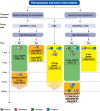CVIT expert consensus document on primary percutaneous coronary intervention (PCI) for acute myocardial infarction (AMI) in 2018
- PMID: 29594964
- PMCID: PMC5880864
- DOI: 10.1007/s12928-018-0516-y
CVIT expert consensus document on primary percutaneous coronary intervention (PCI) for acute myocardial infarction (AMI) in 2018
Abstract
While primary percutaneous coronary intervention (PCI) has significantly contributed to improve the mortality in patients with ST segment elevation myocardial infarction even in cardiogenic shock, primary PCI is a standard of care in most of Japanese institutions. Whereas there are high numbers of available facilities providing primary PCI in Japan, there are no clear guidelines focusing on procedural aspect of the standardized care. Whilst updated guidelines for the management of acute myocardial infarction were recently published by European Society of Cardiology, the following major changes are indicated; (1) radial access and drug-eluting stent over bare metal stent were recommended as Class I indication, and (2) complete revascularization before hospital discharge (either immediate or staged) is now considered as Class IIa recommendation. Although the primary PCI is consistently recommended in recent and previous guidelines, the device lag from Europe, the frequent usage of coronary imaging modalities in Japan, and the difference in available medical therapy or mechanical support may prevent direct application of European guidelines to Japanese population. The Task Force on Primary Percutaneous Coronary Intervention of the Japanese Association of Cardiovascular Intervention and Therapeutics (CVIT) has now proposed the expert consensus document for the management of acute myocardial infarction focusing on procedural aspect of primary PCI.
Keywords: Acute coronary syndrome; Guideline; Percutaneous ventricular assist devices; Plaque erosion; Plaque rupture; ST elevation acute myocardial infarction.
Figures

Similar articles
-
CVIT expert consensus document on primary percutaneous coronary intervention (PCI) for acute myocardial infarction (AMI) update 2022.Cardiovasc Interv Ther. 2022 Jan;37(1):1-34. doi: 10.1007/s12928-021-00829-9. Epub 2022 Jan 12. Cardiovasc Interv Ther. 2022. PMID: 35018605 Free PMC article. Review.
-
CVIT expert consensus document on primary percutaneous coronary intervention (PCI) for acute coronary syndromes (ACS) in 2024.Cardiovasc Interv Ther. 2024 Oct;39(4):335-375. doi: 10.1007/s12928-024-01036-y. Epub 2024 Sep 20. Cardiovasc Interv Ther. 2024. PMID: 39302533 Free PMC article.
-
API expert consensus document on management of ischemic heart disease.J Assoc Physicians India. 2006 Jun;54:469-80. J Assoc Physicians India. 2006. PMID: 16909697 Review.
-
Impact of stent generation on 2-year clinical outcomes in ST-segment elevation myocardial infarction patients with multivessel disease who underwent culprit-only or multivessel percutaneous coronary intervention.Catheter Cardiovasc Interv. 2020 Feb;95(2):E40-E55. doi: 10.1002/ccd.28440. Epub 2019 Aug 18. Catheter Cardiovasc Interv. 2020. PMID: 31423723
-
Angiography-guided Multivessel Percutaneous Coronary Intervention Versus Ischemia-guided Percutaneous Coronary Intervention Versus Medical Therapy in the Management of Significant Disease in Non-Infarct-related Arteries in ST-Elevation Myocardial Infarction Patients With Multivessel Coronary Disease.Crit Pathw Cardiol. 2018 Jun;17(2):77-82. doi: 10.1097/HPC.0000000000000144. Crit Pathw Cardiol. 2018. PMID: 29768315
Cited by
-
Clinical outcomes of patients with acute myocardial infarction undergoing coronary revascularization via simplified treatment: a single-center retrospective study.World J Emerg Med. 2025 Jul 1;16(4):367-373. doi: 10.5847/wjem.j.1920-8642.2025.070. World J Emerg Med. 2025. PMID: 40708740 Free PMC article. No abstract available.
-
Can Clinical and Functional Outcomes Be Improved with an Intelligent "Internet Plus"-Based Full Disease Cycle Remote Ischemic Conditioning Program in Acute ST-elevation Myocardial Infarction Patients Undergoing Percutaneous Coronary Intervention? Rationale and Design of the i-RIC Trial.Cardiovasc Drugs Ther. 2022 Feb;36(1):45-57. doi: 10.1007/s10557-020-07022-9. Epub 2020 Jun 30. Cardiovasc Drugs Ther. 2022. PMID: 32607820
-
Influences of different dose of tirofiban for acute ST elevation myocardial infarction patients underwent percutaneous coronary intervention.Medicine (Baltimore). 2020 Jun 5;99(23):e20402. doi: 10.1097/MD.0000000000020402. Medicine (Baltimore). 2020. PMID: 32501985 Free PMC article.
-
Efficacy and safety of Shexiang Baoxin Pill combined with Western medicine in the treatment of acute myocardial infarction: A single-center, double-blind, randomized controlled trial.Medicine (Baltimore). 2021 Jan 22;100(3):e24246. doi: 10.1097/MD.0000000000024246. Medicine (Baltimore). 2021. PMID: 33546045 Free PMC article.
-
Patient-Related Factors Predicting Stent Thrombosis in Percutaneous Coronary Interventions.J Clin Med. 2023 Nov 28;12(23):7367. doi: 10.3390/jcm12237367. J Clin Med. 2023. PMID: 38068419 Free PMC article. Review.
References
-
- Hochman JS, Sleeper LA, Webb JG, Sanborn TA, White HD, Talley JD, et al. Early revascularization in acute myocardial infarction complicated by cardiogenic shock. SHOCK Investigators. Should we emergently revascularize occluded coronaries for cardiogenic shock. N Engl J Med. 1999;341:625–634. doi: 10.1056/NEJM199908263410901. - DOI - PubMed
-
- Widimsky P, Budesinsky T, Vorac D, Groch L, Zelizko M, Aschermann M, et al. Long distance transport for primary angioplasty vs immediate thrombolysis in acute myocardial infarction. Final results of the randomized national multicentre trial—PRAGUE-2. Eur Heart J. 2003;24:94–104. doi: 10.1016/S0195-668X(02)00468-2. - DOI - PubMed
-
- Steg PG, Bonnefoy E, Chabaud S, Lapostolle F, Dubien PY, Cristofini P, et al. Impact of time to treatment on mortality after prehospital fibrinolysis or primary angioplasty: data from the CAPTIM randomized clinical trial. Circulation. 2003;108:2851–2856. doi: 10.1161/01.CIR.0000103122.10021.F2. - DOI - PubMed
-
- Lincoff AM, Califf RM, Van de Werf F, Willerson JT, White HD, Armstrong PW, et al. Mortality at 1 year with combination platelet glycoprotein IIb/IIIa inhibition and reduced-dose fibrinolytic therapy vs conventional fibrinolytic therapy for acute myocardial infarction: GUSTO V randomized trial. JAMA. 2002;288:2130–2135. doi: 10.1001/jama.288.17.2130. - DOI - PubMed
Publication types
MeSH terms
LinkOut - more resources
Full Text Sources
Other Literature Sources
Medical
Miscellaneous

